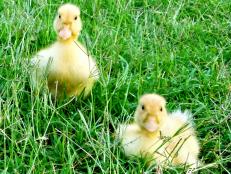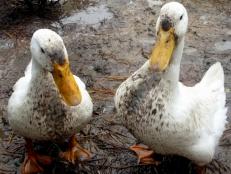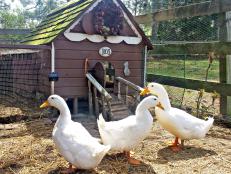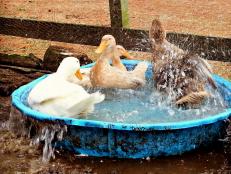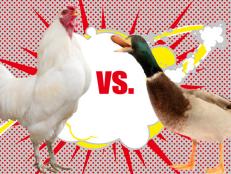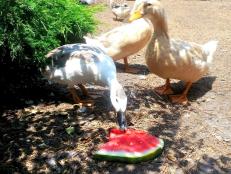Popular Duck Breeds
See these suggestions for friendly, attractive ducks that lay well and aren’t too noisy.

When you think of a typical domestic backyard duck, you probably picture the Aflac duck, which is a white Pekin.
Pekin
Originating in Beijing, China (originally called Pekin) around 2500 B.C., white Pekin ducks are a calm, hardy breed. Although raised predominantly as a “table” or meat bird, Pekins do make wonderful pets and laying ducks. They are docile, friendly and can lay between 150-200 large white eggs per year. Too heavy to fly, they are content to forage on the ground for grasses, weeds, bugs and worms. Pekins don’t tend towards broodiness (meaning the females don’t have a tendency to sit on eggs to hatch ducklings), so artificial incubation is usually needed if you are interested in hatching Pekin eggs. This is a bonus for those looking purely for egg production, since broody ducks stop laying, causing a decrease in production for the period they sit on a nest. Pure white with yellow bills and feet, Pekins have beautiful dark blue eyes. They are considered “heavy” ducks, weighing between 8-9 pounds.
But Pekins are just one of several breeds that would make a wonderful addition to your backyard flock. If you are looking for friendly, attractive ducks that lay well and aren’t too noisy, here are some suggestions:
Indian Runner
Indian Runner ducks originated in Indonesia where rice farmers used them to control insects in the rice paddies. Extremely active and energetic, Runners are excellent foragers. Standing and walking almost upright, they move quickly on land and rarely swim, although they do appreciate a pool to use for baths. They come in various colors including black, buff, fawn, white, gray and chocolate. Fairly light ducks, Runners typically weigh 3 to 5.5 pounds. Good layers of greenish or white eggs, Runners can lay 150-200 eggs per year. Not quite as calm as Pekins, Runners are friendly and make wonderful pets.
Mallard
It is thought that all domestic duck breeds except Muscovies developed from Mallards. Domestic Mallards are small, weighing only about 2.5 pounds, and excellent flyers, so if you choose to raise Mallards, a covered run is recommended to keep them contained. The females are brown with blue wing tips, the males have the distinctive greenish head. Mallards don’t produce as well as other breeds, managing only 60-120 eggs per year, but they lay beautiful greenish eggs and will sit on them (go broody) and hatch out ducklings if you let them. Mallards are a highly energetic and “talkative” breed, more gregarious than the others mentioned here, but extremely good-natured. Backyard Mallards love to paddle around all day in a small kiddie pool or pond.
Duck Breed Photos
See All PhotosKhaki Campbell
The Khaki Campbell breed was developed in England in the early 1900s by crossing the Runner, Rouen and Mallard breeds, and by the 1940s was a recognized breed in the United States. Light brown with a bluish-green bill and brown (female) or orange (male) feet, Khaki Campbells have dark brown eyes. Drakes have greenish heads, a nod to their Mallard blood. Not known for being broody, Campbells are excellent layers, laying more than 300 white eggs per year. Considered a “light” duck breed, Campbells have only limited flying ability and generally weigh 3.5 to 5.5 pounds. A bit more skittish than Pekins, they are still a good choice for family pets, since they are such excellent egg producers and foragers.
Swedish
Originating in Pomerania, which comprised areas of northern Europe and Scandinavia under the control of Sweden, Swedish ducks first arrived in the United States in the late 1800s. Decent layers, the females will produce 120-180 white eggs per year. Blue, black or silver (splash) with white bibs and slate bills, the Swedish breed is attractive and popular for exhibition. Swedish ducks are very calm, extremely hardy, good foragers and difficult for predators to spot. The females do have a tendency to go broody and sit on nests. The Swedish are considered a “heavy” breed and generally weigh between 5 to 6.5 pounds.
Saxony
A fairly new breed to the United States, Saxonies were bred from Rouen, Pekin and Pomeranian duck breeds in the 1930s in Germany as a good all-purpose duck. Almost wiped out during World War II, the breed enjoyed a resurgence in Europe by the 1950s but didn’t reach the United States until 1984. Saxonies are active, alert and energetic. Excellent foragers, they do best with a bit of room to explore and stretch their legs. One of the larger breeds, they weigh 7 to 8 pounds. A beautiful breed that shows well, the males are oatmeal with a burgundy chest, silvery-blue wings and charcoal gray-blue heads with a white ring around their neck and orange bills and feet. The females are fawn-colored with white eye stripes and orange bills and feet. Saxony females lay roughly 200 white eggs per year and will sit on eggs if you allow them the opportunity. Saxony ducks are on the American Livestock Breed Conservancy critical list, with very few breeders in the United States.
Other than Saxonies, the other five breeds are readily available from hatcheries such as Ducks for Backyards or Metzer Farms. Saxonies are a bit more rare and are only available through private breeders at this time.
Regardless of which breed (or breeds) of duck you choose to raise, you will discover the joy and satisfaction of keeping an extremely hardy, good-natured and productive type of poultry. Ducks always seem happy. They are easy to please; seemingly content with fresh food; clean water both to drink and in which to play and swim; a safe place to sleep and plenty of garden scraps, greens and weeds.
Ducks get along fine with chickens in a mixed flock and different breeds of ducks also get along with each other. Most breeds lay white eggs, but Runners, Mallards and a few select other breeds often lay greenish-blue eggs. Cayuga ducks lay charcoal gray or blackish eggs.






